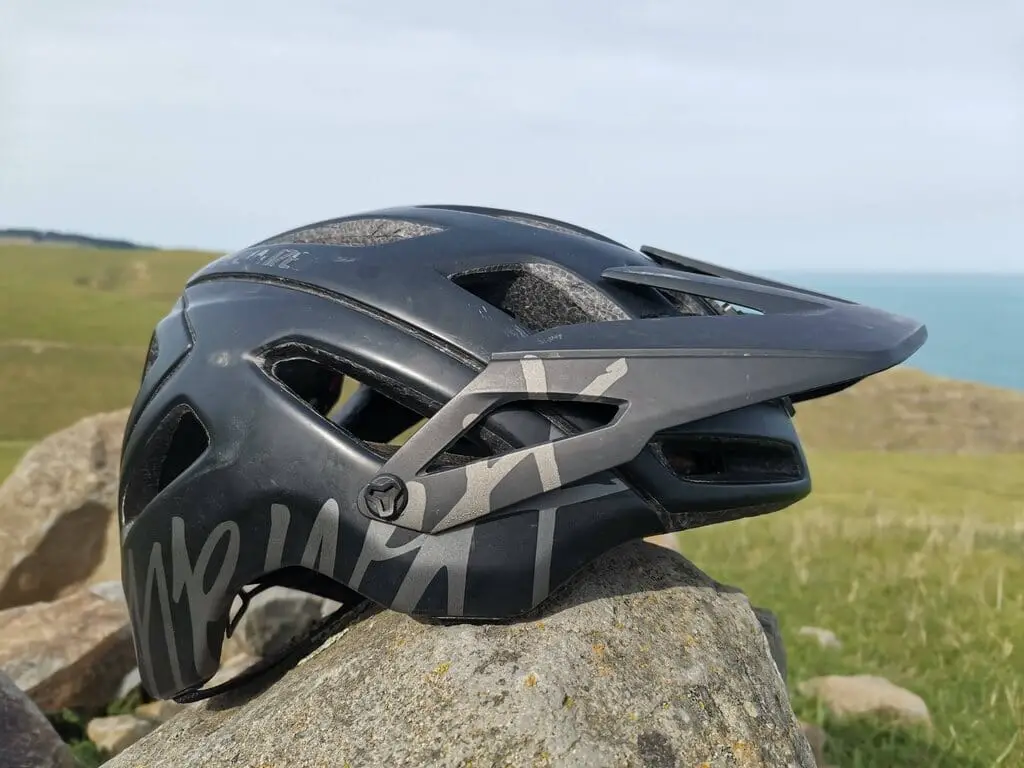Why do mountain bike helmets have visors? The short answer is to protect your eyes against the elements. If you want to learn about types of visors, why they aren’t on road helmets, and the safety of having a visor sticking out of your helmet – read on!
A visor is a section of plastic attached to the front of the helmet. It helps prevent pretty much anything you might expect to be out on the trails from getting into your eyes or face. They are very handy things to have. And they weigh next to nothing, so you barely notice they are there!
- Why does a mountain bike helmet need a visor?
- Why doesn’t a road bike helmet have a visor?
- Types of visors
- Different ways a visor is attached to the helmet
- What length of the visor is best to have on my mountain bike helmet?
- What happens if the visor on my mountain bike helmet breaks off?
- Does having a visor make it unsafe in a crash?
- Should a visor always be used?
- Conclusion
Personally, I always ride with a visor and it is more common to see mountain bike riders with a visor than without.
The visor adds an extra layer of protection from unexpected twigs or low hanging branches that you don’t have enough time (or balance) to take your hands off the bars to push out of the way.
There are so many types of visors out there that I think anyone can find the type and style that suits them best!
Why does a mountain bike helmet need a visor?
A road helmet typically won’t have a visor as it is designed to be as aerodynamic as possible (especially a time trial helmet). A MTB helmet is not as focused on aerodynamics, and more on the comfort of the rider. Below is a number of scenarios I have experienced, and have been thankful that I have a visor on my helmet.
Shield from sun
Picture this. You are riding in a park, full of trees, on a hot and sunny evening. You would think you are pretty much safe from any sunlight reaching you, so you don’t have a visor on your bicycle helmet. Then all of a sudden, the trees become a little less dense, just as you start a steep, gnarly descent. And then the sun starts flickering through the trees, right into your eyes.
Having the sun flickering in your eyes certainly makes it a lot harder to see the trail! Having a visor means for much of the time, the sun will be blocked in these situations. Riding becomes a lot more pleasant when you can see where you are going!
It can also prevent a little more sun reaching your face. This keeps you a little more protected from the scorching sun, which reduces the chances of sunburn while out riding.
Shield from rain
Similar situation to having the sun in your eyes. The visor takes much of the rain for you, leaving your face and eyes much less exposed. Hence you can enjoy your ride that much more!
This is particularly important if you weren’t prepared for the rain and aren’t wearing any glasses. This leads us to the next point.
Shield from mud and dirt from the rider in front
The visor shields your eyes from any loose flying dirt and mud that may flick up while riding. This is particularly important if you are following behind someone who will be inevitably flicking up a bit of mud behind them. And as soon as a bit of mud gets in the eye, it hinders the rider’s sight potentially for the rest of the ride.
Shield from branches
While out riding narrow single tracks, it is common to have the odd branch or two in your way. While hitting the tracks at a blistering pace, taking your hand off the handlebars on uneven terrain becomes a little unsafe. The visor is there to take the brunt of the force from the overhanging branch when you can’t duck under it or avoid it.
Why not just wear glasses?
This is good thinking, as it would likely prevent the sun, mud and rain from getting in your eyes. However, riding the trails with dark tinted glasses makes an often dark, tree-covered park, even darker. This means you may not see that stick you mistook for a shadow, and seeing other objects on the tracks becomes a little more difficult.
It is common for some mountain bikers to wear clear glasses or goggles in conjunction with the visor if they feel the tracks will be extra muddy, dusty or it is raining.
Why doesn’t a road bike helmet have a visor?
Helmets are designed to protect the head of a mountain biker in the event of a crash. A crash on a road bike is often very different from a crash on a mountain bike. Hence it changes the way cycling helmets are designed. A visor would be somewhat handy to have on a road bike, but a ‘design’ crash on a road bike are high-speed slides along a smooth(ish) pavement.
A visor would get in the way as the rider slid across the pavement. Possibly damaging the road cyclist’s neck or head in the process.
This is different for a mountain bike crash. A ‘design crash’ on a mountain bike is more of a thrown up in the air and come back down kind of crash, rather than a slide across the smooth tarmac. Having a visor in the way is negligible considering there is likely banks or rocks in the way. And it will break off before any damage occurs to your head or neck.
Not to mention that the aim of road biking is to be as fast as possible, so aerodynamics is key. A visor doesn’t exactly help with the aerodynamics too much!
Types of visors
There are many types of visors that you will find on bike helmets. Here are the different types and what kind of helmets you will find them on.
Fixed
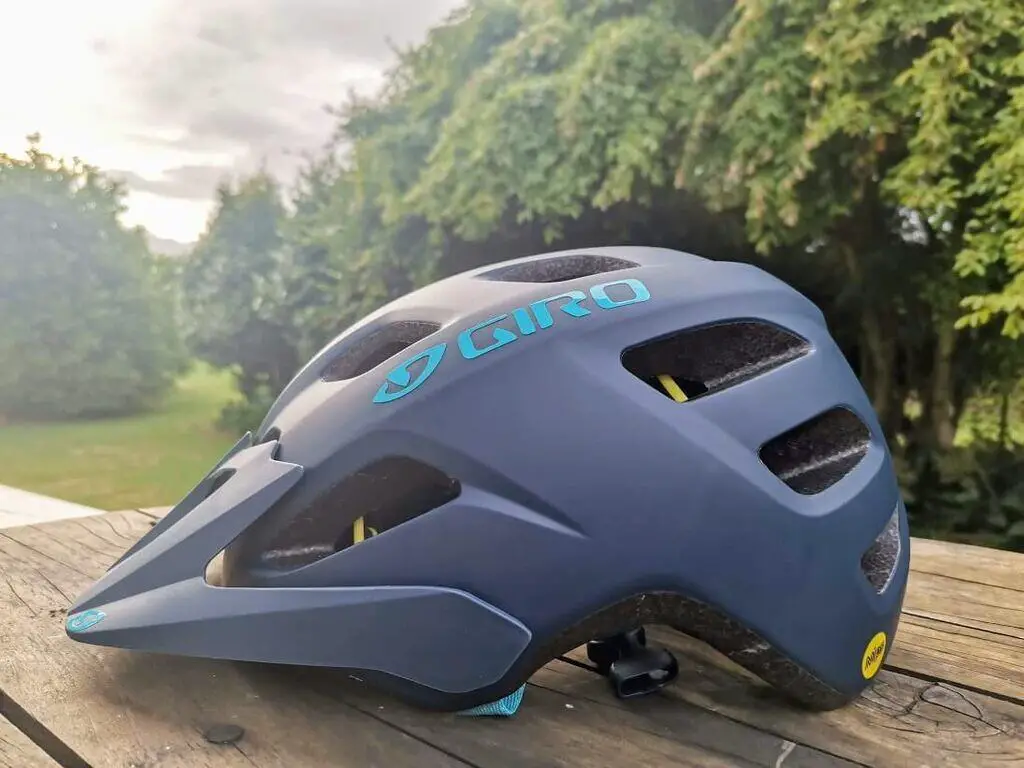
You can get helmets with a visor which do not move up or down. They are attached to the helmet, creating a very sturdy attachment. The visors are typically shorter than adjustable visors as you do not want it to be in your vision while riding.
This style of visor typically comes on less expensive helmets, such as the Giro Fixture, Smith Venture, Bell Nomad and the Bell Spark.
Adjustable
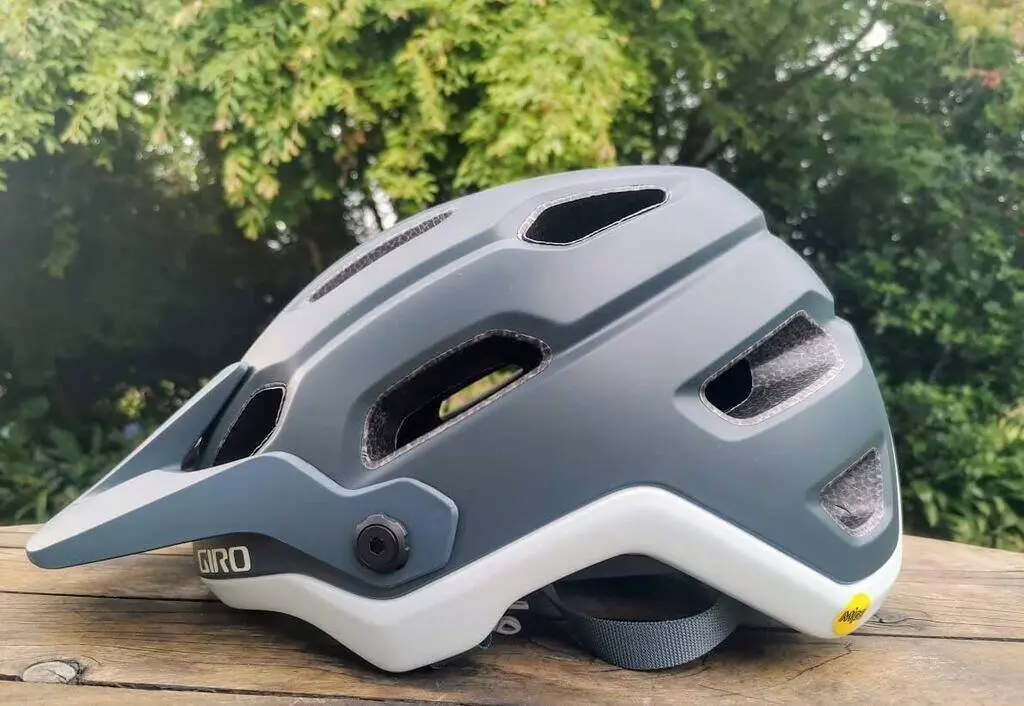
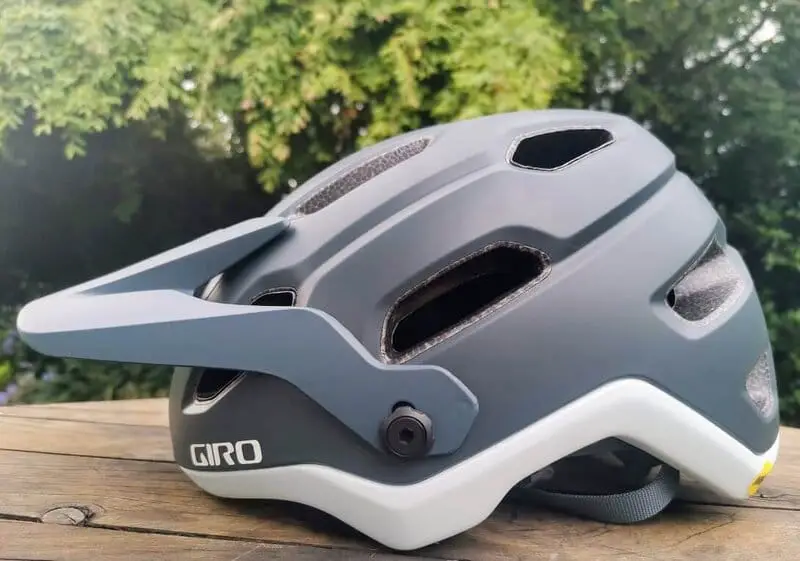
The Giro Source above provides an example of an adjustable visor.
An adjustable visor is attached at two points on either side of the helmet, which allows the visor to move up and down the front of the helmet. This gives the rider the freedom to block the sun as needed, and then be able to move the visor out of the way when it is not needed.
An adjustable visor is typically longer than a fixed visor as it has the freedom to be moved out of the way when it is not needed and can shield your eyes and face a fair bit more when it is needed.
An adjustable visor is typically found on higher-end helmets, which also have improved safety features too. These include the Giro Chronicle, Giro Montaro, Bell 4Forty, and many, many more!
Detachable Visor
Many fixed and adjustable visors can be detachable. This means the visor can be attached when it is needed and detached when it is not needed.
Having a removable visor is quite a popular solution for those riders who want to use the same helmet for road cycling and mountain biking as it turns it into a more aero helmet. If you are one of these riders, see Can I use a Road Biking Helmet for Mountain Biking.
While we don’t recommend using a mountain bike helmet for road cycling or vice versa, this is one option for those who really want to.
Different ways a visor is attached to the helmet
There are many ways that visors can be attached to helmets. Some are better than others and here are the most common types and what type of helmets they appear on.
Screw-on
A screw-in visor is what the higher quality mountain bike helmets use. They are durable, can withstand a few branches and a crash. They are typically screwed into a molded on nut which allows the visor to be adjustable.
A screw-on helmet visor can sometimes be detachable too, which allows it to be taken off and cleaned out in case the rider manages to get a bit of dirt etc. in there.
These are often found on full-face helmets, and any other good quality mountain biking helmet.
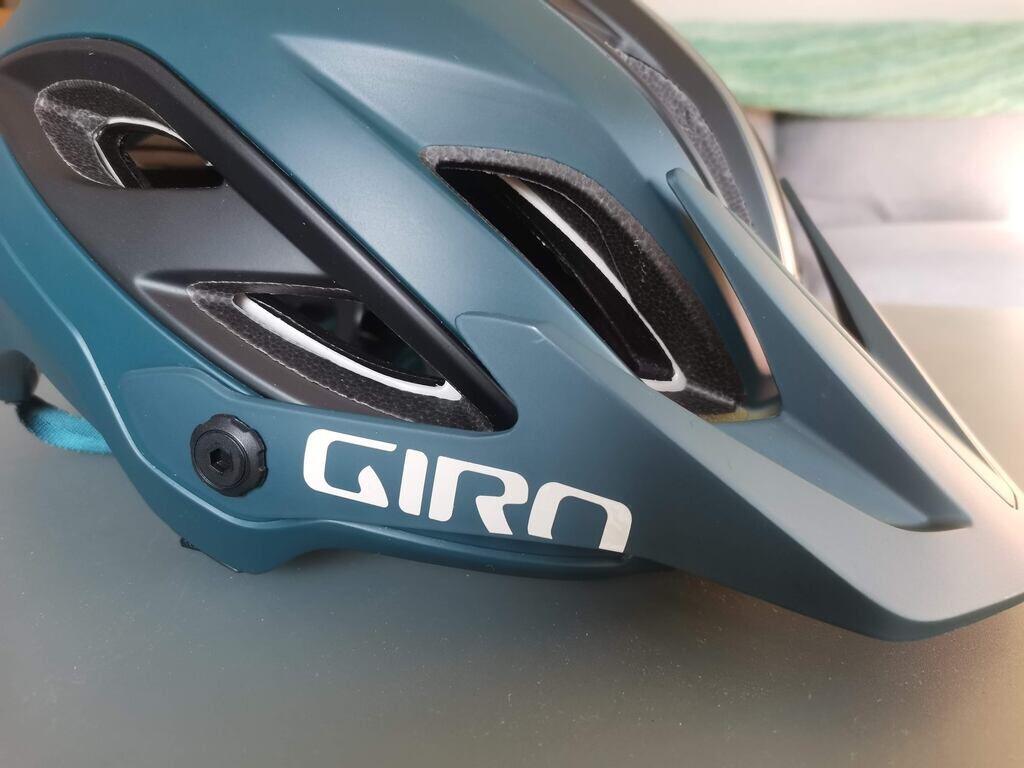
Snap-on
A snap-on visor typically doesn’t last very long. Usually, this method is used for children’s helmets which are expected to be replaced frequently anyway.
It doesn’t take much for the visor to come off. Which is good if a child crashes at a slow pace, stopping the visor from getting in the way. But not so good if an adult is tackling a trail and sweeps past a branch that removes the visor involuntarily.
Snap-on helmets are generally found on cheaper helmets which are not recommended for off-road riding.
Molded-in
This style of attachment is generally used for fixed visors. It stops the visor from being able to move up and down the front of the helmet freely.
What length of the visor is best to have on my mountain bike helmet?
Longer is generally better for protection from the sun and branches etc. However, for a fixed visor, this might be slightly annoying, particularly when climbing. Having a long visor may mean it inhibits your view when climbing, as you are constantly looking up. It is similar to wearing a running cap while out on the trails.
Your vision becomes a bit obstructed once you are looking up, which is why a fixed visor is much shorter. And is why we recommend getting a helmet with an adjustable visor.

What happens if the visor on my mountain bike helmet breaks off?
You can find spare helmet visors online or in a bike store (although they may have to order your particular visor). So if the visor is not made to reattach once it comes off, or if the visor is broken, it can be easily replaced.
For example, you can find the Troy Lee Designs A2 replacement visor on Amazon for a reasonably low cost here.
Does having a visor make it unsafe in a crash?
As stated earlier (under ‘Why doesn’t a road bike helmet have a visor?’) having a visor on a mountain bike does not make it unsafe. If anything, it makes it safer. Your eyes and face will be much more protected by having a visor while out trail riding. Furthermore, in a crash, the visor will break off before any damage occurs to you, your head or your neck.
For more about breakaway camera mounts, check out our post on the best helmets with built in camera mounts.
Should a visor always be used?
Here at MTB Gear Box, we definitely recommend wearing a visor while out mountain biking for several reasons. It does shield your eyes and face from the sun, dirt, mud and branches.
Big brand helmets such as Bell, Giro, and Fox have put a lot of time and money into researching the optimum design. Hence they have shaped for the highest level of protection for their riders. And all of their mountain bike helmets will come with a visor.
If you are a trail rider, ride enduro, or are into downhill riding, a visor should be worn. A road cycling helmet does not need a visor!
Conclusion
Mountain bike visors come with the vast majority of mountain bike helmets. Whether you purchase a fixed visor or an adjustable one, you can be sure that the designers of the helmet have put thought into the size of the visor. They definitely provide a fair bit protection, and you generally will never notice it is there. They are light, make the helmet look good, and provide very useful when riding into the sun!

If you still need a bit of help in deciding on the type of mountain bike helmet is for you, see our other posts,
